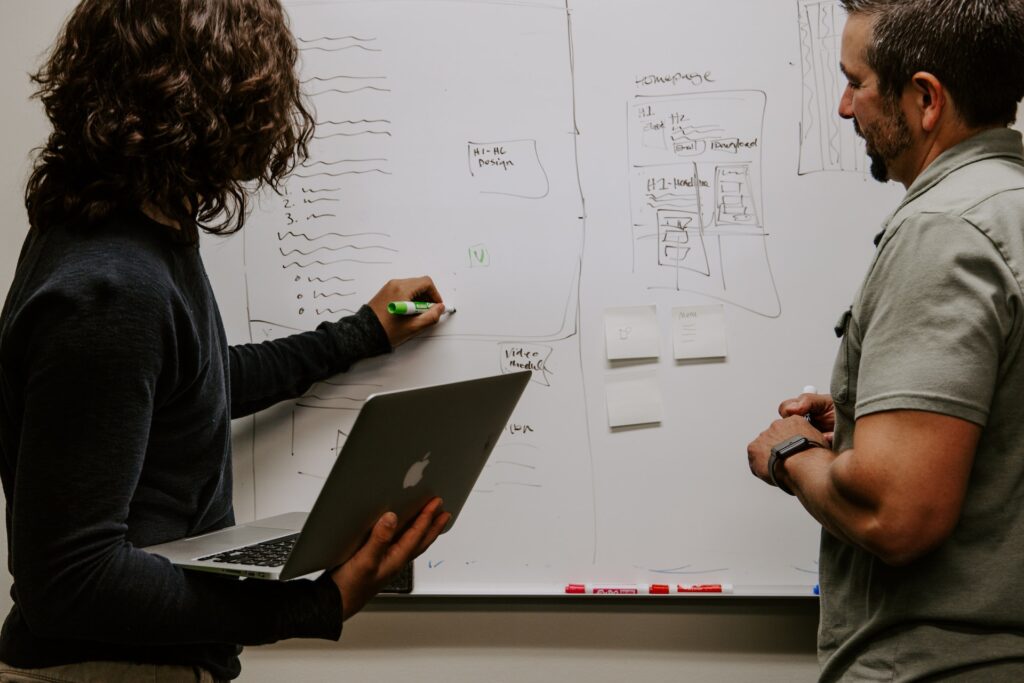Understanding the Differences and Applications of System Thinking and Design Thinking
System thinking and design thinking are both problem-solving approaches that focus on understanding complex systems and developing practical solutions. However, there are some key differences between the two approaches.
System thinking focuses on analyzing the behavior of complex systems by understanding their interactions and interdependencies. It emphasizes the importance of taking a holistic approach and considering the entire system as a whole rather than its individual components. System thinking aims to identify the root causes of problems and develop interventions that take into account the entire system.
On the other hand, design thinking is a human-centered approach that emphasizes empathy, creativity, and experimentation. It involves a structured process of understanding user needs, ideating possible solutions, prototyping, and testing. Design thinking is often used to develop innovative products or services that meet the needs of users.
While both system thinking and design thinking share some similarities, they have different focuses and approaches. System thinking is more focused on analyzing and understanding complex systems, while design thinking is more focused on developing creative and user-centered solutions. Both approaches can be complementary and used together to solve complex problems.
Is it possible to combine both systems into one robust method? Yes, it is! However, before we explore the benefits of their integration, let’s first take a closer look at each method individually.

System Thinking Method
System thinking is an approach that focuses on understanding the behavior of complex systems by analyzing their interactions and interdependencies. It is a way of thinking that helps identify the root causes of problems and design effective solutions that consider the entire system.
Key principles of system thinking:
- Holistic approach: System thinking is a holistic approach that considers the entire system as a whole rather than its individual components. This means that it looks at the interconnections and interdependencies between the various parts of the system to understand how they influence each other.
- Feedback loops: Feedback loops are a critical component of system thinking. They refer to the cause-and-effect relationships between different parts of the system, where the output of one component becomes the input of another component and vice versa. Feedback loops can be either reinforcing or balancing and understanding these loops is crucial for predicting the behavior of the system.
- Mental models: Mental models refer to the assumptions and beliefs that people have about how the world works. These models can influence the decisions and actions of individuals, and they can also affect the behavior of entire organizations. System thinking helps to identify and challenge these mental models to promote a more accurate understanding of the system.
- Boundaries: Defining boundaries is essential in system thinking. Boundaries help to determine what is included in the system and what is not, and they also help to identify the interactions and interdependencies between different parts of the system.
- Time delays: Time delays are another crucial component of system thinking. They refer to the time it takes for a component of the system to respond to a change in another component. Understanding time delays is essential for predicting the behavior of the system over time and designing effective interventions.
Applications of system thinking:
System thinking has a wide range of applications in various fields, including business, healthcare, education, and environmental management. Some examples of how system thinking can be applied include:
Business
In business, system thinking can be used to identify the root causes of problems such as low employee morale, inefficient processes, and declining profits. By analyzing the interactions and interdependencies between different parts of the organization, system thinking can help to design interventions that address these problems and promote sustainable growth.
Healthcare
In healthcare, system thinking can be used to improve patient outcomes by identifying the factors that influence health outcomes, such as social determinants of health, access to care, and quality of care. By taking a holistic approach and considering the entire system, system thinking can help to design interventions that promote health equity and improve the overall health of the population.
Education
In education, system thinking can be used to improve student outcomes by identifying the factors that influence student success, such as curriculum design, teacher training, and school culture. By analyzing the interactions and interdependencies between different parts of the education system, system thinking can help to design interventions that improve student outcomes and promote educational equity.
Environmental management
In environmental management, system thinking can be used to design interventions that promote sustainable development and protect the environment. By understanding the interactions and interdependencies between different parts of the ecosystem, system thinking can help to design interventions that promote biodiversity, reduce pollution, and mitigate the effects of climate change.
System thinking is a powerful approach that can help to solve complex problems in various fields. By taking a holistic approach and considering the entire system, system thinking can help to identify the root causes of problems and design effective solutions that promote sustainable growth and improve outcomes for individuals and communities.
Design Thinking
Design thinking is a human-centered approach to problem-solving that involves empathy, creativity, and experimentation, often connected to UX design field. It is a process that helps designers and non-designers alike to understand user needs and develop innovative solutions to complex problems.
Key principles of design thinking:
- Empathy: Empathy is the foundation of design thinking. It involves understanding the needs and perspectives of users and designing solutions that meet their needs. Empathy helps designers to create solutions that are user-centered and address the real problems that users face.
- Define: Defining the problem is the next step in the design thinking process. It involves defining the problem that needs to be solved and identifying the goals and objectives of the project. Defining the problem helps to ensure that the solution is focused and meets the needs of users.
- Ideate: The ideation phase of the design thinking process involves generating a wide range of ideas and solutions. It encourages designers to think creatively and brainstorm new possibilities. The ideation phase is a time to explore different options and challenge assumptions.
- Prototype: Prototyping involves creating a physical or digital representation of the solution. Prototyping helps to test and refine the solution and identify any issues or areas for improvement. Prototyping is an important part of the design thinking process because it allows designers to get feedback from users and refine the solution.
- Test: Testing is the final phase of the design thinking process. It involves testing the solution with users and gathering feedback. Testing helps identify any issues or areas for improvement and ensures that the solution meets users’ needs.
Applications of design thinking:
Design thinking has a wide range of applications in various fields, including business, healthcare, education, and technology. Some examples of how design thinking can be applied include:
Business
In business, design thinking can be used to develop new products and services that meet the needs of customers. Using a user-centered approach, design thinking can help identify new market opportunities and develop solutions that differentiate the business from competitors.
Healthcare
In healthcare, design thinking can be used to improve patient outcomes by identifying the needs and preferences of patients. By developing solutions focused on patients’ needs, design thinking can help improve the patient experience and increase patient satisfaction.
Education
In education, design thinking can be used to develop innovative teaching methods and learning tools that meet the needs of students. By using a user-centered approach, design thinking can help to identify the needs and preferences of students and develop solutions that improve the quality of education.
Technology
In technology, design thinking can be used to develop new software and applications that meet the needs of users. By using a user-centered approach, design thinking can help to identify the needs and preferences of users and develop solutions that are intuitive and easy to use.
Design thinking is a powerful approach to problem-solving that emphasizes empathy, creativity, and experimentation. Using a user-centered approach, design thinking can help develop innovative solutions that meet users’ needs and address complex problems in various fields. Whether you are a designer or a non-designer, design thinking can help you think more creatively and develop solutions that positively impact the world.
The Power of Combining Design Thinking with System Thinking Methods
Combining design thinking with system thinking methods can create a powerful problem-solving approach that takes into account both the user-centered perspective of design thinking and the holistic perspective of system thinking. Combining these two methods makes it possible to develop solutions that are creative, user-centered, effective, and sustainable.
Here are some ways in which design thinking and system thinking can be combined:
Holistic User Research
Design thinking emphasizes the importance of empathizing with users and understanding their needs. System thinking focuses on understanding the behavior of complex systems by analyzing their interactions and interdependencies. By combining these two approaches, it is possible to conduct user research that takes into account the entire system and the interactions between different parts. This can lead to a more accurate understanding of the user’s needs and the system’s behavior.
User-Centered System Analysis
System thinking is often criticized for being too technical and not considering the user’s perspective. By combining system thinking with design thinking, it is possible to conduct system analysis that is also user-centered. This can help identify the root causes of problems and develop interventions that consider the user’s needs and preferences.
Creative System Design
Design thinking is known for its creative approach to problem-solving. By combining design thinking with system thinking, it is possible to develop creative solutions that also take into account the entire system. This can lead to solutions that are not only innovative but also effective and sustainable.
Testing and Iteration
Both design thinking and system thinking emphasize the importance of testing and iteration. By combining these two approaches, it is possible to develop solutions that are not only tested with users but also take into account the entire system’s behavior. This can lead to solutions that are not only user-centered but also effective and sustainable.
Implementation and Evaluation
System thinking emphasizes the importance of implementation and evaluation. By combining design thinking with system thinking, it is possible to develop solutions that are innovative and user-centered but also effective and sustainable in the long run. This can lead to solutions that positively impact the entire system and achieve the desired goals and objectives.
Conclusion:
Combining design thinking with system thinking methods can create a powerful problem-solving approach that takes into account both the user’s perspective and the behavior of the entire system. Combining these two approaches makes it possible to develop solutions that are creative, user-centered, effective, and sustainable. Whether you are working in business, healthcare, education, or environmental management, combining design thinking with system thinking can help you to solve complex problems and achieve your goals and objectives.
Encouraging everyone in the organization to embrace the combined methods of design thinking and system thinking can have several awesome benefits! First, it can create a work environment that encourages creativity and innovation, focusing on what the user really needs and how the whole system works. Second, this can lead to solutions that not only rock but also have a positive impact in the long run. Plus, it can bring people together across different teams and departments to collaborate and break down any barriers. Third, using the same approach across the organization, it makes communication and problem-solving a lot easier. Finally, it empowers everyone to contribute their unique ideas and perspectives to the team’s problem-solving efforts. All in all, embracing this approach can make the organization more effective and enjoyable for everyone involved!



